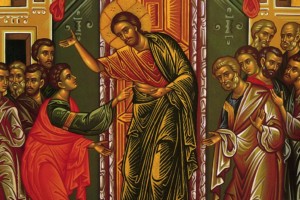Sunday of Thomas
(John 20:19-31)

The Sunday of St Thomas follows after Easter Bright Week (Lambri Evdomada).
The Gospel reading commences with the disciples assembled together in fear. Jesus comes and shows them His wounded hands and side (v 20). In doing so he dispels all doubt about who He is.
Thomas was not present at Jesus’ appearance. When told by the others, Thomas showed his doubt (v 25).
Jesus appeared again to the assembled disciples. This time Thomas was present (v 26-27). Like the Good Shepherd in the parable of the lost sheep, Jesus came back especially for Thomas. As a hymn of our Church states, “Jesus did not want Thomas to drown in the storm of disbelief.” He also manifests again His love for mankind, which was proven in His crucifixion. The high point of the passage is Thomas’ confession of Christ’s divinity: “My Lord and my God!” (v 28), which showed that he was open and willing to accept this truth.
It is easy to emphasise Thomas’ doubt in Christ’s resurrection. When we look deeper we obtain an understanding that Thomas was driven by his pain of not being amongst the disciples when Jesus first appeared to them. We understand that Thomas had a readiness to believe.
Nevertheless, doubt is human and is not a weakness. It can be the impetus to search for answers and the truth. Some people unfortunately respond to doubt by giving up the search or becoming complacent and despondent.
Let us, who have not seen the resurrected Christ with our physical eyes, always search diligently for the truth with our spiritual eyes. If we do this, by careful daily reading of the Bible, by partaking in the Church’s liturgical life, and by seeking guidance from a spiritual elder, Jesus will approach each of us to answer our doubts. Then we too will be blessed, for though we have not seen with our physical eyes, we will have seen with our spiritual eyes, and will believe.
Source: Lychnos April-May 2020
